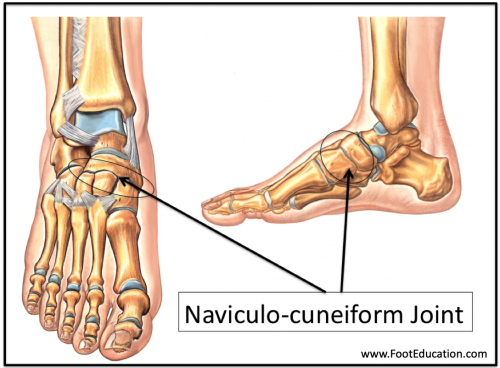Naviculocuneiform Joint Fusion
(Arthrodesis)
Edited by Daniel Guss, MD MBA
Indications
The naviculocuneiform joint is a series of joints between the navicular bone and the three cuneiform bones in the middle of the foot and towards the top of the arch (Figure 1). While there is not a lot of motion through this joint, there is still cartilage between the bones and when that cartilage wears away, arthritis may set in generating pain. In addition, if the supporting ligaments around the joints stretch out, it may lead to arch collapse with a deformity through these joints. Normally, there is hardly any motion through these joints.
If the arthritis between the navicular bone and the cuneiform bones becomes severely painful, or if the arch is collapsing through the joints so that the foot is no longer a normal shape and this causes pain or difficulty walking, it may be necessary to fuse these joints. A fusion means to scrape away any cartilage in the joints, roughen up the bony surfaces, and then squeeze the bones together to get them to heal into one larger bone. If this successfully heals, there is no longer a joint that can painfully rub or deform the foot, potentially decreasing pain and improving foot alignment.
Figure 1- Naviculo-Cuneiform Joint

Procedure
A naviculocuneiform fusion involves making an incision on the top or slightly to the side of the middle of the foot and exposing the navicular and cuneiform bones. The joints are then opened up and the cartilage covering the joint surface is removed. The bone is roughened to expose healthy, bleeding bone, and then the bones are squeezed together across the joints with either screws or plates. In some instances, a bone graft will be applied to increase the chance of healing.
Recovery
Recovery from surgery to fuse the naviculocuneiform joint may be dictated by other surgeries that have been done in conjunction with this procedure. However, typical recovery from this procedure is 2-3 months of non-weightbearing (no weight on the foot) in order to allow the bones to heal without the forces of walking. It can be challenging to get the navicular to heal to the cuneiform bones, and therefore it is not uncommon for fusion of the naviculocuneiform joint to require a longer period of non-weightbearing in order to encourage healing. Once the bone is healed, patients can gradually increase activity initially in a stiff-soled boot and eventually in a comfortable shoe. It is common for this surgery to take 9 or 12 months to reach the point of full recovery.
Potential Complications
General Complications
As with other surgeries, there is always a risk of general complications which may include:
- Wound healing problems
- Infection
- Damage to nerves and other structures
- Deep vein thrombosis (DVT)
- Pulmonary embolism
Specific Complications
Complications that are specific to a naviculocuneiform fusion include:
- Nonunion. The naviculocuneiform joints can be a difficult joint to get to fuse, partly because of a poor blood supply. In addition, if the joint has been destabilized by a collapsing arch, this increased mobility can put increased force through the joint as it heals, predisposing to a nonunion.
- Nerve Injury. Branches of the nerves that run to the top of the foot run over the naviculocuneiform joints. An injury to one of these nerves can lead to a decrease or loss of sensation on top or mid or inside of the foot, or even a burning type irritation. Iin rare instances, a complex regional pain syndrome can develop.
Edited February 11, 2020
mf/3.12.18